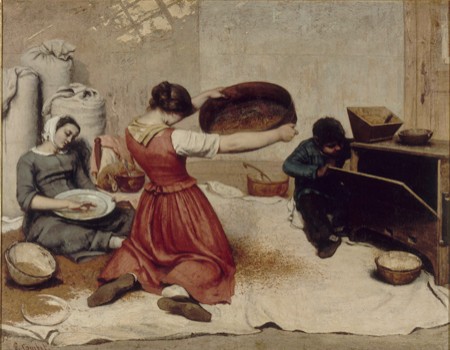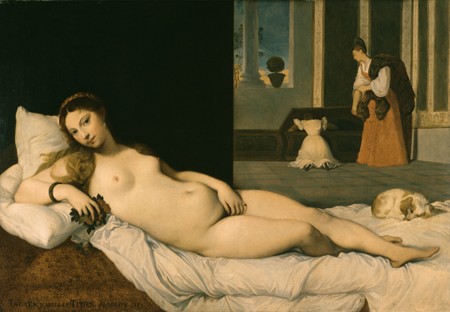Eugène Delacroix used the word amphibologie in his personal journal to criticize Gustave Courbet for creating the illusion of what Delacroix called “vrai ciel” at the center of the programmatic painting The Artist’s Studio (Musée d’Orsay, Paris). Amphibologie (amphibology) is not a common term in artistic theory. Following César Dumarsais’s definition in Diderot and d’Alembert’s Encyclopédie, it is a “terme de grammaire” describing a phrase that has two different meanings. Dumarsais concludes his entry with a warning: Amphibology has to be avoided, especially when talking to small children, who have to be addressed with clarity (clarté) of language. Delacroix may have been drawn to use this term by Courbet’s depiction in The Artist’s Studio of a small boy at the center of the painting who watches the artist working on the illusionistic sky and who, according to Delacroix, may represent a child misled by lack of clarity. For Courbet the boy seems to be a metaphor for the ideal viewer of his work, the true witness, who, not spoiled by any tradition, looks with a fresh eye, totally unprejudiced. This image of a myth of modernism seems to have been neither understood nor accepted by Delacroix, who considered pictorial clarity to be lacking in a painting that he in fact truly admired.
The Artist’s Studio was exhibited in 1855 as the central work in Courbet’s realist pavilion, next to the Exposition Universelle. There Courbet presented another painting using the motif of a child looking at something. In The Wheat Sifters (Musée des beaux-arts de Nantes), one sees to the right a boy peering into a boxlike winnowing machine. What he sees is invisible to the viewer; he looks into one of Courbet’s famous voids, like the dark zones of water in his river paintings, the dark center in his grotto images, or the grave in his monumental A Burial at Ornans. Is this childish curiosity or juvenile inventiveness? If the boy stands for the future, is the machine he examines meant to take over the work of the two women in the foreground of the picture? Courbet’s father was an agricultural inventor, and his son seems to have been aware of the profound structural changes in agriculture going on during that time. Indeed, a new winnowing device had just been invented by a miller in Lyons named Vachon and presented successfully at the Great Exhibition in London in 1851, and the Exposition Universelle of 1855 in Paris saw the triumph of the first McCormick reaper.
Members' Research Report Archive
Courbet’s Amphibologie
Ulf Küster, Fondation Beyeler, Riehen / Basel
Ailsa Mellon Bruce Visiting Senior Fellow, January 5–February 28, 2014

Gustave Courbet, The Wheat Sifters, 1854. Musée des beaux-arts de Nantes, 874. © RMN-Photographie (G. Blot)

Jean-Auguste-Dominique Ingres after Titian, Reclining Venus, 1822. The Walters Art Museum, Baltimore
Courbet had not invented the motif of looking inside something without letting the viewer see what is there. Indeed, in his realist manifesto of 1855 Courbet declared that he had developed his individuality as an artist in the full awareness of artistic tradition, and he may have based his Wheat Sifters on motifs from one of the most famous Renaissance images, transforming (and thus vulgarizing) it as a scene of rural labor: Titian’s Venus of Urbino. I do not suggest that Courbet copied this painting, but he seems to have found inspiration in it and may have paraphrased parts of it. The kneeling woman in the background, looking inside a cassone, or marriage chest (its interior invisible to the viewer); the standing woman in her red dress and white blouse with rolled-up sleeves; the sleeping dog: these are all motifs Courbet seems to have used in varied form in his composition. Particularly interesting are the edges of the cassone and the grain-sifting box, which define pictorial space in each painting respectively.
Had Courbet seen Titian’s painting in Florence? No, but he may have seen Jean-Auguste-Dominique Ingres’s copy of it (The Walters Art Museum, Baltimore), which later became part of the collection of Khalil Bey, owner of Courbet’s Origin of the World, among other paintings. The Wheat Sifters is not the only painting Courbet based on the inspiration of tradition. Reusing and varying famous models seem to have been a strategy for questioning and playing with the expectations of viewers and for developing something like an individual iconography.
The insights gained during my residency at CASVA will contribute to a larger intensive study of Courbet that also includes curating an exhibition, to be shown at the Fondation Beyeler, and publication of a related book.